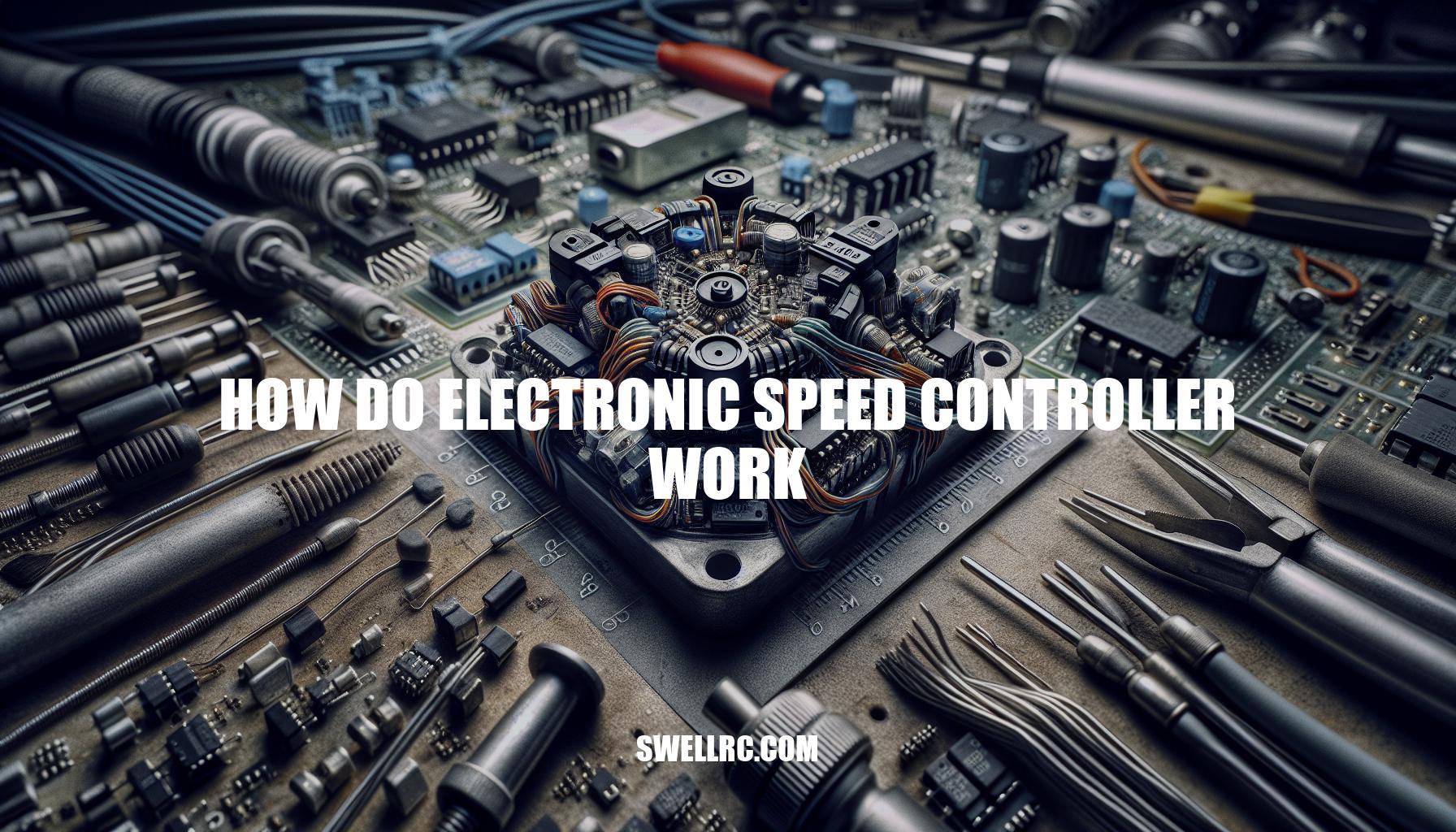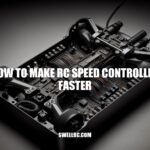How Do Electronic Speed Controllers Work: Complete Guide and Operation
When you’re flying your drone over a breathtaking landscape, you’re probably not thinking about the wonders happening under the hood. Yet, there’s one component in there that’s truly the heart of the action – it’s called an Electronic Speed Controller (ESC). This cool little gadget is like the “maestro” of your drone. Its job? To dictate the ‘tempo’ of the electric motor, controlling its power, and hence its speed. Let’s think of it as an orchestrator of power, if you will. Now, ESCs aren’t just found in drones. They’re nestled inside RC cars, wind turbines, and a lot of other nifty technological systems. With the increasing popularity and sales of tech toys like drones and RC cars, the role of ESCs is becoming more significant than ever. So, isn’t it super exciting to dig into how this unsung hero works? Buckle up, because we’re about to embark on a thrilling ride into the world of ESCs!
How Electronic Speed Controllers Work
Let’s dive deeper into how electronic speed controllers work. At the heart of any ESC is its ability to regulate power. Instead of delivering a continuous stream of energy, the ESC sends fast pulses of current to the motor. Your motor doesn’t just chug along, it dances to the rhythm of energy pulses – much like a car engine firing on all cylinders. This seemingly chaotic system is actually brilliantly efficient, and it’s all coordinated by an ESC’s onboard microprocessor.
This microprocessor, a tiny but mighty component, dictates when and how the power pulses are sent. Data from manufacturer guides indicate that it receives information about the desired speed from the control signal (usually your remote control), and rapidly adjusts the frequency and width of the energy pulses to maintain that speed. It’s like the world’s busiest traffic conductor, managing a highway of energy, directing power traffic at lightning speed.
The RobotShop guide explains this further. The rate of these pulses, or ‘Pulse Width Modulation’ (PWM), is vital in determining both the speed and steadiness of the motor’s rotation, even adding extra torque when you need it most. More pulses equate to increased speed, fewer pulses ensure slower speeds. This enables you to perform precision manoeuvres, whether you’re racing an RC car or piloting a drone. So next time you’re pulling off an impressive aerial stunt or nailing a tight racetrack bend, remember: it’s all thanks to how intricately your ESC works!
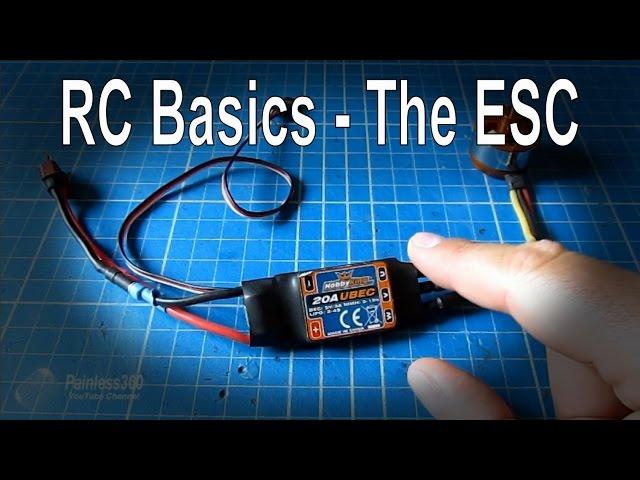
What is Pulse Width Modulation (PWM) and how does it affect the speed and steadiness of a motor’s rotation controlled by an electronic speed controller?
Oh, I see you’re interested in Pulse Width Modulation, or PWM, quite a nifty trick, isn’t it? Essentially, it’s a method that allows us to control just how much power we’re giving to an electronic device – like a motor. Imagine your motor has a mailbox and you’re deciding how many letters (power) you’re sending to it. If you give it too many letters at once, it’ll be overwhelmed. This is where PWM waltzes in. It divides these “letters” into teeny tiny pieces and deliver them in a measured way.
How does PWM affect your motor’s speed and steadiness, you ask? In simple terms, the more power it receives, the faster it spins. Pulse Width Modulation dictates the number of voltage “pulses” or “letters” if you wish, your motor receives in a given time-frame, influencing how quickly or smoothly it rotates. Picture this – the longer the pulse ‘width’ (or how long your letter is) the more power the motor gets, making it go faster. Similarly, a shorter pulse width provides less power, slowing things down.
You know the jittery start-stop motion in some motors? That’s usually because power is being dumped on them all at once. With PWM, it’s almost like the motor is getting a steady stream of sweet whispers instead of a loud shout. So, in essence, PWM is the clever little idea that lets you control the speed and smoothness of your motor’s rotations, making your venture into the realm of electronic speed controllers a heck of a lot easier. Let’s say, it’s the secret ingredient to a well-behaved motor – a motor that does exactly as you intend. Fun, isn’t it?
The Evolution of ESCs: From Brushed to Brushless
How do electronic speed controller work? Well, the two key players in this game are brushed and brushless ESCs. Historically speaking, the tradition was to use brushed models. They’re named this way because they actually use brushes that come into physical contact with the motor’s rotor to control the current and switch motor poles. While the concept may sound appealing due to its simplicity, it had its drawbacks. The mechanical contact inherent in these models came with friction and wear-and-tear that ultimately reduced the efficiency and lifespan of these ESCs.
Fast forward to the present, we’re living in the era of brushless models. These state-of-the-art ESCs manage to control the motor’s speed through magnetism, completely eliminating the need for brushes. The magic all happens because of electrical signals sent from the ESC to the motor, which then vary the orientation of the motor’s magnetic field. This technique potentially offers more power and efficiency and, since there’s no mechanical contact, it reduces strain and wear on the motor. Plus, brushless ESCs have the added advantage of being quieter, a tick in the win column for drone enthusiasts who value discretion.
So how does this technological evolution fit into the bigger picture of the RC world? Websites like Hobbyking, a top source for RC parts, show a clear trend towards brushless ESCs for most enthusiasts’ projects. The shift here represents the tech world’s constant drive for improvement, making your RC cars, drones, or boats ‘run smoother and faster, something every gearhead can appreciate!

What are the advantages of using a brushless ESC compared to a brushed model?
Ah, the age-old debate between brushless and brushed Electronic Speed Controllers (ESCs)! Here’s the deal my friend, brushless ESCs come with a boatload of pros and I can personally vouch for them.
Firstly, they are super-efficient. Unlike their brushed counterparts, they don’t cause as much friction, and thus loss of power is significantly lower. We all crave maximizing power output, right?
Secondly, brushless ECSs are durable champs. They don’t have brushes that wear out, so they tend to have a much better lifespan. If you’re like me, constantly replacing parts can be a hassle, so the longevity is a real bonus!
Last but not least, these dudes are quiet operators. They run smoother and much quieter. For all those peaceful evening flights or races, this can be a game-changer. You can totally enjoy your soaring journey without any annoying buzz or motor noise.
Now, I understand stepping into the brushless territory might seem a bit daunting due to the initial cost. But, if you consider the power efficiency and durability, it’s a worthy investment. Trust me, once you’ve tasted the brushless power, you’ll never go back. Don’t forget, ultimate aim here is to rev up the thrill, and a brushless ESC gives you just that!
How ESCs Work – The Key Performance Metrics
Now, let’s delve into the heart of how do electronic speed controllers work – the performance trade-offs and advantages between different ESC models. One crucial aspect to consider is the power-to-weight ratio. In simple terms, it’s about the amount of power that each gram of the ESC can handle. A high power-to-weight ratio means your electric motor can deliver more speed with less weight, making it a critical feature for gadgets like racing drones or high-performance RC cars. Furthermore, efficiency is another barometer often overlooked. A highly efficient ESC can translate electrical energy into mechanical power more effectively, which means longer flight or run times for your machines. This is akin to having a fuel-efficient car – more mileage on fewer batteries!
Returning to the matter at hand, heat dissipation is another significant performance metric. Let’s bring this to a more human level – consider when you exercise, your body heats up, right? Similarly, an ESC tends to get warm, thanks to the power running through it. Superior heat dissipation means your ESC can handle higher currents without risking burnout, akin to a marathon runner with an excellent cooling system. Sounds cool, doesn’t it?
In addition, let’s touch on responsiveness. This is how fast an ESC reacts to throttle changes. Quicker responses equal better control and maneuverability, especially vital for devices requiring intricate movements like quadcopters. Imagine a dancer reacting to music – that’s what a responsive ESC does, it ‘dances’ fast to the ‘music’ of your commands.
To give you a concrete example, let’s focus on an industry-leading ESC model. The Hobbywing Platinum Pro V4 features an impressive power-to-weight ratio, efficient performance, excellent heat dissipation and quick response time. You see, the numbers matter, but so does the dance!
That said, every ESC performs differently based on its components and technology, and these differences bring their own sets of pros and cons. So, make sure to choose the one that fits your specific needs! After all, understanding how electronic speed controllers work goes hand-in-hand with knowing what works best for you. Remember, the right choice will make your electric motor purr like a well-tuned luxury sports car!
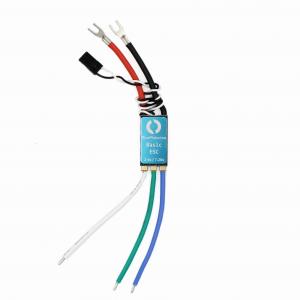
What is the power-to-weight ratio and why is it important in electronic speed controllers for racing drones and high-performance RC cars?
The power-to-weight ratio, my friend, is all about the relationship between how much oomph something has compared to its weight. This is super important when you start looking into electronic speed controllers (ESCs) in things like race-ready drones and high-octane RC cars. Now you might be wondering, why does it matter? Well, it’s a balancing act really.
When an ESC can manage and deliver a lot of power, without piling on too much weight, it gives these amazing racing devices the quick response and high-speed capability they need without dragging them down. Think of it like trying to run your fastest with a lightweight backpack, rather than a heavy one – makes sense, right? Picture your drone or RC car as an athlete: the stronger and lighter they are, the better their performance is going to be.
Now here’s the geeky bit. ESCs manage the power from the battery to the motors and thus control the speed. So, having a high power-to-weight ratio in an ESC allows for better, more precise speed control. This results in sleek movements and greater acceleration. Trust me, in those high-speed drone races or RC car rallies, every millisecond counts, and an ESC with a high power-to-weight ratio can make the difference between victory and defeat. So yes, the power-to-weight ratio is somewhat of a vital component in the adrenaline-pumped world of racing drones and RC cars!
Firmware: The Brains Behind ESC Performance
Talking about the heart and soul of an ESC, you really can’t ignore the impact of incredible firmware, like BLHeli and SimonK. These aren’t just flashy tech terms, my dear reader. They play a crucial role in how electronic speed controller work, truly taking their functionality to the next level.
Both BLHeli and SimonK are open-source firmware that offer a range of nifty features. For example, BLHeli offers flexibility in terms of motor timing, brake strength, and start-up power, and it’s compatible with a wide range of ESCs, making it quite the multi-tasker.
Keeping that in mind, the bigger question is, what are these timing and startup power settings? At a basic level, these settings let you determine how fast or slow your ESC responds to throttle changes. It’s like having a specialized tool-ket that allows you to tweak and tinker around with the workings of your ESC. Believe it or not, these settings have a real-time effect on your flight experience.
On the other hand, SimonK, with its lightning-fast refresh rates, is the go-to firmware for those in need of a zero-lag drone or RC car experience. It’s like that turbo mode button in racing games that instantly injects adrenaline into your drone or RC vehicle, giving it the edge in terms of responsiveness.
Surfing through user testimonials on forums, you will observe a common wave of appreciation for these firmware’s ability to significantly enhance the ESC’s performance. People all around the globe have noticed smoother throttle responses, unprecedented stability during flight, no stuttering motors, and improved user experience.
So, to cut a long story short, the firmware is not just computer code. It’s the brain that supports your ESC in performing its best. And the widely endorsed developers of BLHeli and SimonK understand well that a smoother user experience comes with a smarter brain – the firmware.
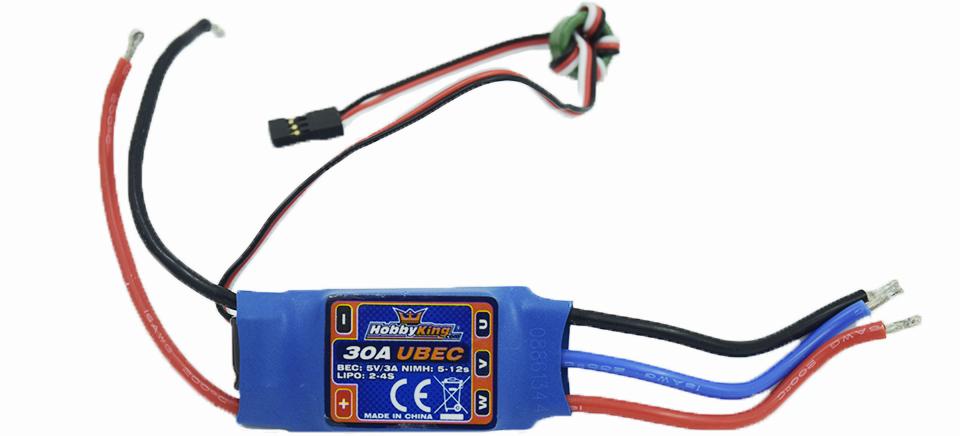
What are the benefits of using BLHeli and SimonK firmware in electronic speed controllers?
You know, there’s something special about using BLHeli and SimonK firmware in electronic speed controllers that gets me excited. They genuinely take your drone, helicopter, or any electric motor controlled equipment to a whole new level! As I’ve come to realize, they both offer smooth throttle response, which is absolutely essential when controlling how your drone moves. As you can imagine, having that precise control can make all the difference when you’re trying to capture that perfect aerial shot or simply enjoy a smooth ride.
These firmwares understand the need for speed and high-performance. They both support high RPM motors, unlocking that extra zip you feel when your drone takes off. Like boiling an egg to perfection, it’s all a matter of precision—just that we’re talking electric motors here!
Additionally, these firmwares provide improved efficiency and a wider operating voltage range. Imagine it like this: They are like the exceptional coordinators who ensure everything works smoothly behind the scenes in a big event. Your speed controllers need to be of top-notch quality to handle any surprises, and that’s exactly what BLHeli and SimonK deliver!
Believe it or not, they have revolutionized the electronic speed controller game with their refreshingly fast and regular updates. It’s like having a smart assistant who constantly evolves and learns to become more efficient, ensuring your speed controllers are always updated with the latest and greatest tweaks in the tech world.
Finally, what I truly appreciate is that these firmwares come with easy calibration and setup, a godsend for us non-tech guru folks! No need to break a sweat or turn to Google every time we need to make a change. Overall, it’s fair to say that BLHeli and SimonK are a match made in heaven for our beloved electronic speed controllers!
Now that we’ve dived deep into the ‘how do electronic speed controller work’ ocean, it’s time to talk about something we all face, the hurdles and the bumps in the road. No matter how advanced the technology, there are always potential problems to overcome, from puzzling syncing issues to pesky overheating troubles. Take it from someone who has experienced it; nothing can be more frustrating than an underperforming ESC disrupting your perfect drone flight or RC race day.
Fortunately, the vast world of technology has provided a solution to almost every problem we might encounter. Did you know that an average repair costs much less than buying a new ESC? And it’s even cheaper if you have the knowledge to troubleshoot the issues yourself – great news for DIY-lovers like myself!
Accurate data suggests that those who take the time to understand their ESCs, diagnose issues early and take corrective measures experience significantly less downtime in their activities. Trust me, no one wants to sit on the sideline while everyone else is out there, enjoying their smoothly operating RCs. So it pays to keep an eye open for any signs of problems.
So there you go, understanding how an electronic speed controller works, its different types and the vital role of firmware is your first step. Your journey in troubleshooting and maintenance is another powerful arrow in your quiver. Keep these tips in mind, and you’ll be an ESC whiz in no time. And remember, just like in life, problems are opportunities in disguise to learn and level up. So give it a go, take that step forward and happy troubleshooting!

